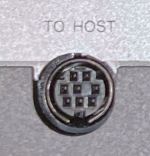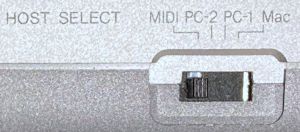Serial MIDI: Difference between revisions
m (→Overview: Mac not MAC) |
(Move summary of usefulness to lede, put it in its own paragraph) |
||
| Line 2: | Line 2: | ||
[[File:Yamaha QY70 right HOST SELECT crop.jpg|thumb|right|300px|The HOST SELECT switch on a [[Yamaha QY70]].]] | [[File:Yamaha QY70 right HOST SELECT crop.jpg|thumb|right|300px|The HOST SELECT switch on a [[Yamaha QY70]].]] | ||
Many MIDI modules and similar devices from the 1990's feature a port labelled "'''TO HOST'''" or "'''COMPUTER'''", which can be used with an appropriate cable to connect the device directly to a computer's serial port. This is also sometimes referred to as "'''Serial MIDI'''". From roughly 1999 onwards, USB started to appear alongside or instead of these ports. | Many MIDI modules and similar devices from the 1990's feature a port labelled "'''TO HOST'''" or "'''COMPUTER'''", which can be used with an appropriate cable to connect the device directly to a computer's serial port. This is also sometimes referred to as "'''Serial MIDI'''". | ||
Connecting to the computer this way is an alternative to using the normal MIDI ports that does not require use of a MIDI interface. It also often provides additional features, like additional virtual MIDI ports, or being able to use the device as a MIDI interface for connecting additional MIDI devices. | |||
From roughly 1999 onwards, USB started to appear alongside or instead of these ports. | |||
== Overview == | == Overview == | ||
| Line 14: | Line 18: | ||
Each mode (aside from the MIDI port mode) requires a different, special adapter cable. | Each mode (aside from the MIDI port mode) requires a different, special adapter cable. | ||
== With modern computers == | == With modern computers == | ||
Revision as of 01:29, 14 September 2024


Many MIDI modules and similar devices from the 1990's feature a port labelled "TO HOST" or "COMPUTER", which can be used with an appropriate cable to connect the device directly to a computer's serial port. This is also sometimes referred to as "Serial MIDI".
Connecting to the computer this way is an alternative to using the normal MIDI ports that does not require use of a MIDI interface. It also often provides additional features, like additional virtual MIDI ports, or being able to use the device as a MIDI interface for connecting additional MIDI devices.
From roughly 1999 onwards, USB started to appear alongside or instead of these ports.
Overview
Typically, these ports can operate in three to four modes, selected via a switch on the device (usually labelled something like "HOST SELECT"):
- A mode designed for the modem port on old Apple Macintosh computers. This mode is usually labelled "Mac" or "RS422".
- A mode designed for NEC PC-9800 series computers (sold only in Japan). This mode is usually labelled "PC-1" or "RS232C-1". Some devices from the later 1990's omit this mode.
- A mode designed for the 9-pin or 25-pin serial port on IBM PC/AT-compatible computers (common worldwide). This mode is usually labelled "PC-2" or "RS232C-2".
- A mode where this port is not used, and instead the MIDI ports are used. This mode is usually labelled "MIDI".
Each mode (aside from the MIDI port mode) requires a different, special adapter cable.
With modern computers
Modern computers generally do not feature serial ports compatible with this port. Using USB (if available on the module) or a USB MIDI interface (connected to the module's MIDI ports) is usually more practical with modern computers.
However, there are alternative solutions. User:Valley Bell has created an open-source hardware project that allows turning an Arduino board into a serial MIDI to USB MIDI adapter.